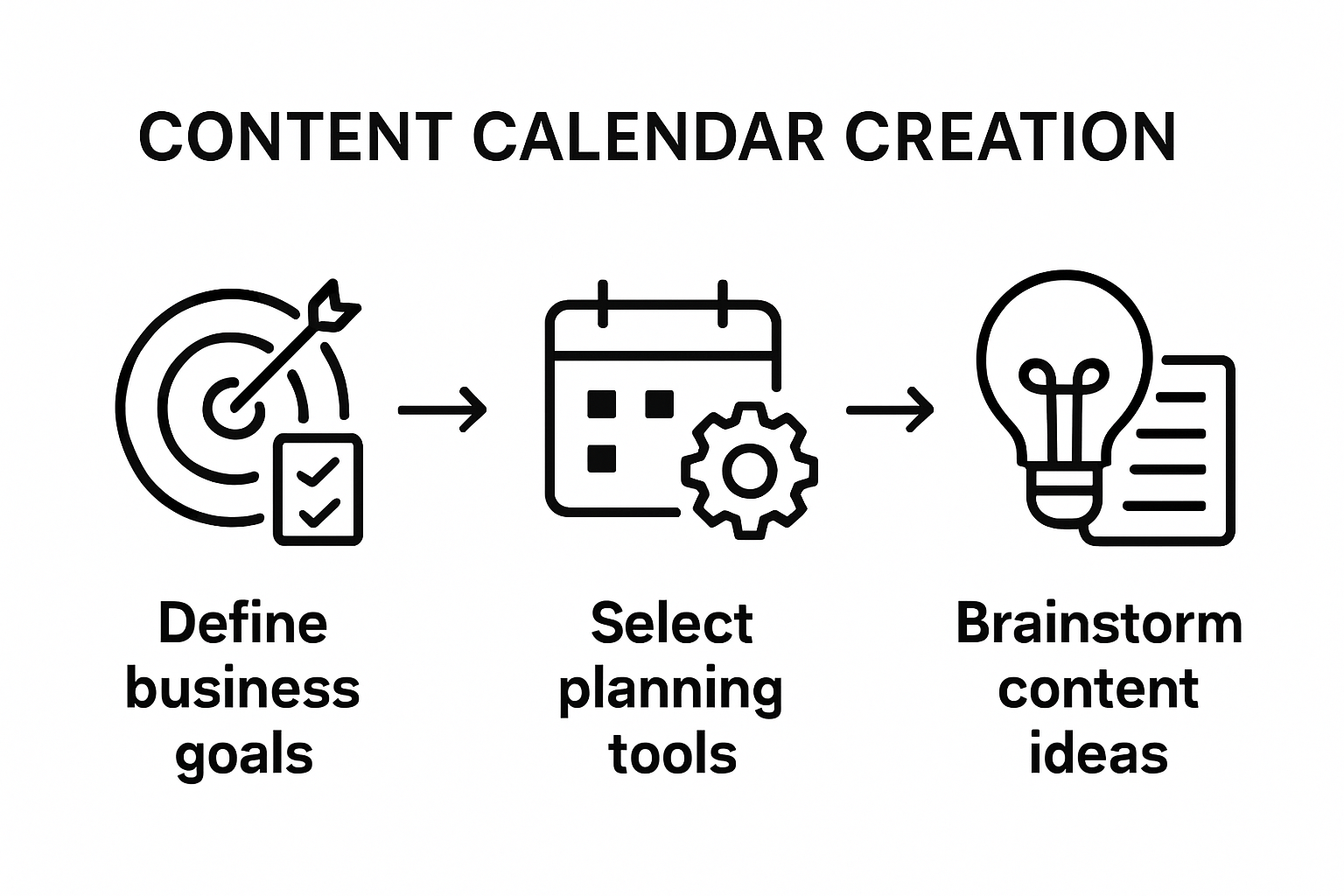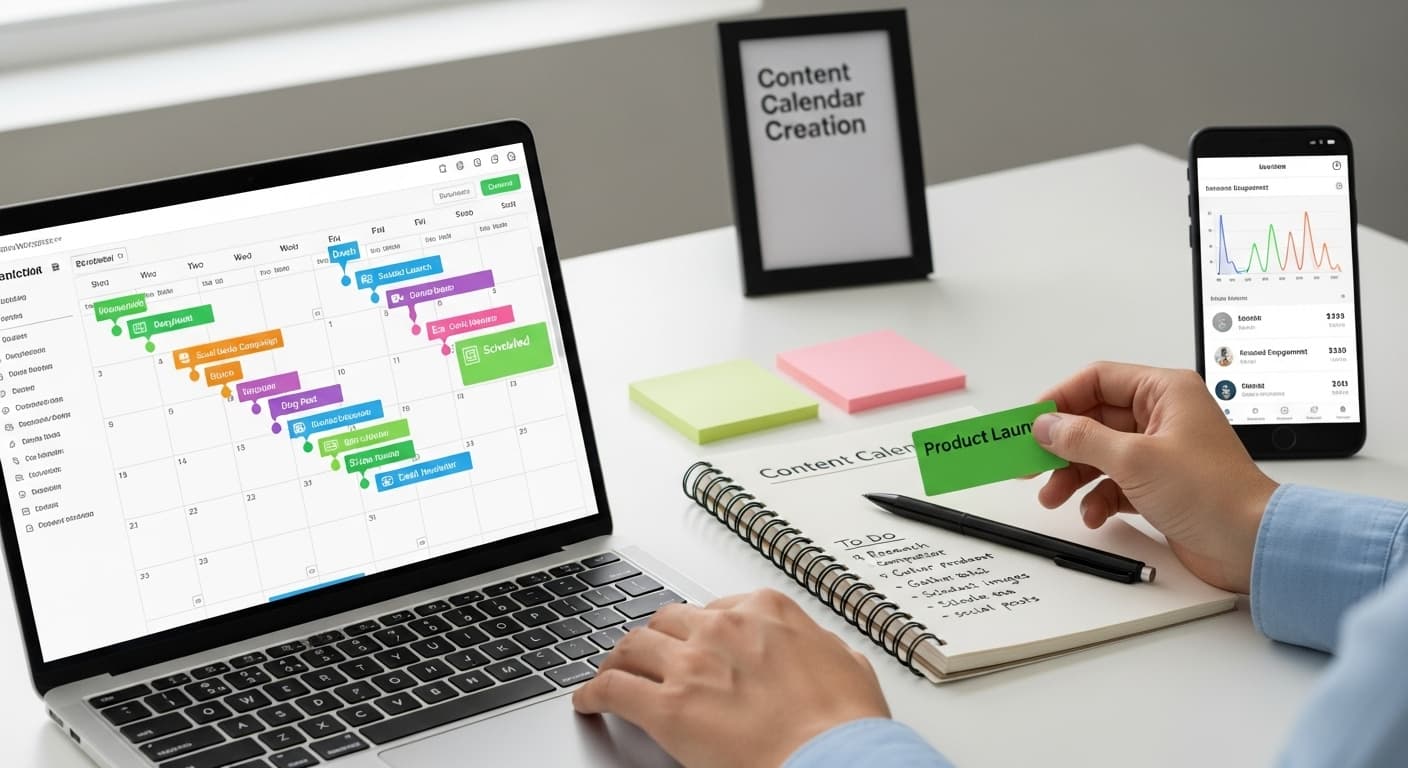Master Content Calendar Creation for eCommerce Success
Building a content calendar can feel overwhelming for ecommerce teams, especially when trying to juggle marketing campaigns and product launches. And yet, studies show that businesses with organized content calendars are 60 percent more likely to describe their marketing as effective. Most people think content calendars are just about scheduling posts, but the real secret is strategic planning that transforms each piece of content into a clear step toward business growth.
Table of Contents
- Step 1: Define Your Business Goals And Target Audience
- Step 2: Select Tools For Effective Planning And Collaboration
- Step 3: Brainstorm Content Ideas Aligned With Marketing Strategies
- Step 4: Organize Your Content Topics Into A Monthly Calendar
- Step 5: Schedule Content Distribution Across Multiple Channels
- Step 6: Review And Optimize Content Performance Regularly
Quick Summary
| Key Point | Explanation |
|---|---|
| 1. Define clear business goals | Identify specific, measurable objectives to guide content creation and strategy. |
| 2. Understand your target audience | Develop comprehensive audience personas based on customer insights and research. |
| 3. Select the right planning tools | Use project management platforms for collaboration and effective content tracking. |
| 4. Organize content into a calendar | Create a monthly content calendar aligned with business cycles and audience needs. |
| 5. Regularly review content performance | Continuously analyze metrics to optimize your content strategy for better results. |
Step 1: Define your business goals and target audience
Successful content calendar creation begins with crystal clear strategic foundations. Your business goals and target audience are the compass that guides every piece of content you will create. Without understanding these fundamental elements, your content strategy becomes a random collection of posts without purpose or direction.
Starting with business goals means identifying specific, measurable objectives that your content will support. Are you looking to increase brand awareness, drive online sales, improve customer retention, or establish thought leadership in your ecommerce niche? Each goal requires a nuanced content approach. For instance, brand awareness might demand more educational and storytelling content, while sales conversion needs more product-focused and persuasive material.
Defining your target audience requires deep research and genuine understanding. You need to go beyond basic demographics and develop comprehensive audience personas. What are their pain points? What motivates their purchasing decisions? What channels do they frequent? Learn more about audience segmentation to create more precise targeting strategies.
To craft effective audience personas, gather data from multiple sources. Analyze your current customer base, review website analytics, conduct surveys, and examine social media interactions. Look for patterns in age, income, interests, online behavior, and purchasing habits. Create a detailed profile that represents your ideal customer, including their goals, challenges, and potential objections to purchasing.
Once you understand your business goals and target audience, you can align your content calendar to speak directly to their needs and desires. This alignment ensures that every piece of content serves a strategic purpose, whether it’s educating, entertaining, or converting potential customers. Your content becomes a powerful tool for building relationships and driving business growth.
Verify your foundation by asking these key questions:
- Do you have 2-3 clearly defined business objectives?
- Have you developed comprehensive audience personas?
- Can you articulate how your content will address specific audience needs?
If you can confidently answer yes to these questions, you have successfully completed the first crucial step in content calendar creation.

Step 2: Select tools for effective planning and collaboration
Creating a successful content calendar requires more than just great ideas. You need robust tools that enable seamless planning, collaboration, and execution. Content collaboration platforms have transformed how marketing teams coordinate their efforts, making strategic content management more accessible than ever.
Choosing the right tools depends on your team’s specific workflow, size, and complexity. For ecommerce brands, the ideal platform should offer visual project management, real-time collaboration, and integration capabilities with other marketing systems. Spreadsheets like Google Sheets can work for smaller teams, but growing brands need more sophisticated solutions that provide comprehensive content tracking and workflow management.
Project management platforms are the backbone of effective content calendar creation. Tools like Asana, Trello, and Notion offer customizable workflows that allow you to track content from ideation through publication. These platforms enable team members to assign tasks, set deadlines, add comments, and monitor progress in real-time. For ecommerce teams juggling multiple product launches, marketing campaigns, and content streams, visual kanban boards and timeline views become invaluable for maintaining organization.
When selecting collaboration tools, prioritize platforms that integrate smoothly with your existing marketing technology stack. If your team uses Klaviyo for email marketing, ensure your content calendar tool can connect or export data easily. Look for features like automated notifications, permission settings, and content preview capabilities. Some advanced platforms even offer AI-powered content suggestions and performance tracking, which can significantly streamline your content creation process.
Consider your budget and scalability when evaluating tools. Many platforms offer tiered pricing models, allowing you to start small and expand as your team grows. Free versions often provide basic functionality, while paid plans unlock more advanced features like detailed analytics, unlimited team members, and custom branding.
Below is a comparison table of popular project management tools mentioned for planning and collaboration, summarizing their key features and advantages for ecommerce content calendar workflows.
| Tool | Key Features | Best For | Integration Capabilities |
|---|---|---|---|
| Asana | Custom workflows, task assignment, real-time collaboration | Growing teams needing advanced tracking | Integrates with Slack, Google Drive, and email marketing platforms |
| Trello | Visual kanban boards, easy task tracking, timeline views | Visual planners and small teams | Works with Zapier and supports add-ons for automation |
| Notion | Customizable pages, task management, commenting | Flexible structures and documentation | Connects to many tools via API or embed links |
| Google Sheets | Spreadsheet-based, simple collaboration | Small teams and basic content calendar needs | Imports/exports data, limited workflow integration |
Verify your tool selection by checking these key criteria:
- Does the platform support your current team size and workflow?
- Can it integrate with other essential marketing tools?
- Does it provide the necessary collaboration and tracking features?
- Is the pricing sustainable for your business?
By carefully selecting the right planning and collaboration tools, you transform your content calendar from a static document into a dynamic, actionable strategy that drives your ecommerce success.
Step 3: Brainstorm content ideas aligned with marketing strategies
Brainstorming content ideas is the creative heartbeat of your content calendar, transforming strategic goals into compelling narratives that resonate with your audience. Content marketing strategies thrive on innovative ideation that connects directly with customer needs and business objectives.
Effective content ideation requires a structured yet flexible approach. Begin by mapping your content ideas to specific business goals identified in your initial planning stage. For ecommerce brands, this might mean creating content that addresses customer pain points, showcases product benefits, or demonstrates brand expertise. Consider developing content that covers the entire customer journey, from awareness to purchase and post-purchase engagement.
Dive deep into your audience research to uncover content opportunities. Analyze customer support tickets, review platforms, social media comments, and website search queries to identify topics your audience genuinely cares about. Pay attention to the language customers use, as this reveals their real concerns and interests. Tools like Google Trends, social listening platforms, and keyword research software can provide additional insights into trending topics and customer search behaviors.
Explore our guide on understanding storytelling in marketing to transform these insights into compelling content ideas. Your brainstorming sessions should be collaborative, involving team members from different departments. Sales teams can offer customer interaction insights, product teams can share technical details, and customer support can highlight common questions and challenges.
Create a diverse content mix that keeps your audience engaged. This might include product tutorials, customer success stories, behind-the-scenes glimpses, industry trend analyses, and educational content that positions your brand as a thought leader. For ecommerce brands, consider content formats like unboxing videos, styling guides, comparison articles, and user-generated content showcases.
Verify your content ideation process by checking these key points:
- Do your content ideas directly support specific business goals?
- Have you generated ideas that cover different stages of the customer journey?
- Is there a good balance of content types and formats?
- Can you trace each idea back to customer insights or research?
Remember, great content ideas are not just creative sparks but strategic tools that connect your brand with your audience, driving engagement and ultimately, business growth.
Step 4: Organize your content topics into a monthly calendar
Developing a monthly content calendar transforms random content ideas into a strategic roadmap that keeps your ecommerce brand consistently engaging and relevant. This step bridges your brainstorming efforts with practical execution, ensuring a systematic approach to content creation.
Strategically mapping content across months requires careful consideration of your business cycles, customer journey, and industry trends. Start by identifying key dates specific to your ecommerce brand such as product launches, seasonal promotions, holiday shopping periods, and industry events. These anchor points will provide structure to your content planning, allowing you to create timely and contextually relevant materials.
Consider developing a color-coded or categorized system that helps visualize content distribution. Assign different colors or tags to content types like product tutorials, customer stories, educational posts, and promotional materials. This approach ensures a balanced content mix that prevents audience fatigue and maintains engagement across various touchpoints. Your monthly view should showcase a diverse yet cohesive narrative that guides potential customers through their purchasing journey.
Timing and frequency are critical components of your content organization. Determine the optimal posting schedule for each content type across different channels. Email newsletters might work best weekly, while blog posts could be bi-weekly, and social media content might require daily updates. Align your content frequency with your team’s production capacity to maintain consistent quality and prevent burnout.
Incorporate flexibility into your monthly calendar. While structure is important, ecommerce brands must remain agile to respond to market changes, customer feedback, or unexpected opportunities. Leave some buffer spaces in your calendar for timely, reactive content that can capitalize on trending topics or address emerging customer needs.
Verify your monthly content calendar by checking these essential criteria:
- Does your calendar cover all planned business and marketing objectives?
- Have you balanced different content types and channels?
- Is the content distribution realistic given your team’s resources?
- Are there provisions for unexpected content opportunities?
A well-organized monthly content calendar becomes more than a scheduling tool. It transforms into a strategic document that guides your brand’s storytelling, ensures consistent communication, and ultimately drives customer engagement and conversion.

Step 5: Schedule content distribution across multiple channels
Effective content distribution requires a strategic approach that maximizes your reach and engagement across diverse digital platforms. This step transforms your carefully crafted content into a powerful, multi-channel communication strategy that connects with your audience wherever they are most active.
Understanding each platform’s unique dynamics is crucial for successful content distribution. Email marketing, social media, blog platforms, and website channels each demand tailored content approaches. For ecommerce brands, this means adapting your core message to suit the communication style and audience expectations of each channel. An Instagram post might require vibrant visuals and concise messaging, while an email newsletter allows for more detailed storytelling and product insights.
Learn more about scaling your digital marketing strategies to enhance your distribution efforts. Develop a cross-channel content matrix that outlines specific distribution tactics for each platform. For example, a product tutorial might start as a comprehensive blog post, then be repurposed into shorter video snippets for TikTok, infographic slides for LinkedIn, and key takeaways for email newsletters. This approach maximizes content efficiency and reaches different audience segments through their preferred communication channels.
Timing and frequency play critical roles in content distribution. Research your audience’s online behavior to determine optimal posting times for each platform. Use analytics tools to track when your followers are most active and likely to engage with your content. Some platforms like Facebook and Instagram offer built-in scheduling tools, while third-party platforms like Hootsuite or Buffer can help you manage cross-platform distributions more efficiently.
Consider the technical requirements and best practices for each channel. Image dimensions, character limits, hashtag strategies, and content formatting differ significantly across platforms. Prepare platform-specific content variations in advance to ensure smooth, professional distribution that maintains your brand’s visual and messaging consistency.
Verify your content distribution strategy by examining these key points:
- Have you mapped content to appropriate channels?
- Are distribution times optimized for audience engagement?
- Can each piece of content be easily adapted across platforms?
- Do you have a system for tracking performance across different channels?
Successful content distribution is not about flooding every platform with identical content, but creating a harmonious, strategic approach that amplifies your brand’s message and connects meaningfully with your target audience.
Step 6: Review and optimize content performance regularly
Continuous content performance optimization is the key to sustained marketing success, transforming your content calendar from a static document into a dynamic, responsive strategy. This final step ensures your ecommerce content remains relevant, engaging, and aligned with evolving business goals and audience expectations.
Establishing a robust performance tracking system begins with identifying the right metrics for your specific business objectives. Different content types demand different evaluation criteria. Product tutorial videos might be measured by watch time and conversion rates, while blog posts could be assessed through engagement metrics like time on page, social shares, and comments. Explore strategies to boost your online sales performance to understand how content performance directly impacts revenue.
Utilize analytics tools across your marketing platforms to gather comprehensive performance data. Google Analytics, Klaviyo, social media insights, and email marketing dashboards provide granular information about how your audience interacts with different content pieces. Pay attention to not just quantitative metrics like views and clicks, but qualitative indicators such as audience sentiment, comment quality, and user feedback.
Implement a quarterly review process that goes beyond surface-level numbers. Conduct deep-dive analyses that reveal patterns in content performance. Which topics generate the most engagement? What types of content drive actual conversions? Are there seasonal trends affecting your content’s effectiveness? These insights will help you continuously refine your content strategy, eliminating underperforming content types and doubling down on what resonates with your audience.
Be prepared to pivot quickly. The digital marketing landscape evolves rapidly, and your content calendar should reflect this dynamism. Set up a system for rapid content iteration that allows you to test and implement changes based on performance data. This might involve A/B testing different content formats, experimenting with posting times, or adjusting messaging to better align with audience preferences.
Verify your performance optimization process by checking these critical elements:
- Have you established clear, measurable performance benchmarks?
- Are you tracking both quantitative and qualitative content metrics?
- Do you have a systematic approach to reviewing and updating content strategy?
- Can you demonstrate tangible improvements from your optimization efforts?
Remember, a content calendar is a living document. Regular review and optimization transform it from a mere scheduling tool into a powerful, adaptive marketing asset that grows and evolves with your business.
Here is a verification checklist summarizing the key criteria to assess the effectiveness of your content performance optimization process.
| Verification Step | Description |
|---|---|
| Clear, measurable performance benchmarks | Establish KPIs tied to your main business goals |
| Tracking of both quantitative and qualitative metrics | Monitor analytics like clicks, engagement, sentiment |
| Systematic approach for review and updates | Conduct quarterly reviews to analyze performance |
| Demonstrating tangible improvements from optimization efforts | Show evidence of increased engagement, conversions |
Transform Content Calendars into Revenue with Strategic Email Automation
You have put in the hard work to define business goals, identify customer pain points, and organize content across every channel. Yet, truly effective ecommerce content does not stop at great planning. To turn that strategy into measurable results, your content calendar must do more than schedule — it must drive real engagement and revenue. Many brands struggle with connecting content efforts to bottom-line growth, leaving opportunities for customer retention and sales on the table.

Now is the moment to bridge your content strategy with powerful email marketing. Take Action specializes in transforming well-planned content into automated email flows, high-converting campaigns, and targeted segmentation. Our team uses Klaviyo for automations like welcome sequences and abandoned cart recovery, then brings in AI-driven insights to optimize every message. If you want to see your content calendar directly fueling revenue while building long-term customer relationships, work with Take Action today. Ready to unlock the next level of ecommerce growth? Visit our site and see how we align detailed planning with high-performing email strategies built for brands like yours.
Frequently Asked Questions
What are the first steps in creating a content calendar for eCommerce?
Successful content calendar creation starts with defining your business goals and understanding your target audience. This foundational step ensures that your content serves a strategic purpose and aligns with customer needs.
How can I effectively brainstorm content ideas for my eCommerce content calendar?
To brainstorm content ideas, map them to specific business goals and analyze customer interactions through support tickets, social media comments, and website search queries. This will help you generate ideas that resonate with your audience.
What tools should I use for planning and collaboration on a content calendar?
You should consider project management platforms like Asana, Trello, or Notion, which offer features for task assignment, tracking progress, and real-time collaboration. Look for tools that integrate with your existing marketing technology stack for optimal efficiency.
How often should I review and optimize my content performance?
It is recommended to conduct a quarterly review of your content performance. This should include analyzing metrics relevant to your business objectives and making updates to your content strategy based on insights gathered from audience engagement and performance data.
Recommended
- 7 Essential Ecommerce Marketing Strategies for Growth | Take Action Blog | Take Action
- What is a Content Hub? Understanding its Importance | Take Action Blog | Take Action
- How to Boost Social Shares for Ecommerce Success | Take Action Blog | Take Action
- 7 Branding Mistakes to Avoid for Your Ecommerce Brand | Take Action Blog | Take Action
- Maximize Sales with Content Marketing for Ecommerce
